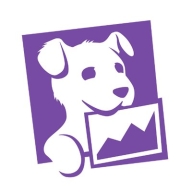

Datadog and Coroot compete in the application performance monitoring category. Datadog shows a strong edge with its comprehensive data analytics and robust integration options, making it suitable for complex monitoring needs.
Features: Datadog includes extensive integration options, real-time data analytics, and a sophisticated alerting system. Coroot benefits from simplicity, ease of use, and targeted monitoring capabilities.
Ease of Deployment and Customer Service: Datadog's deployment model handles extensive infrastructure needs and is supported by a robust support network, suitable for environments needing detailed customization. Coroot offers a simpler and faster deployment suited for smaller operations, focusing on essential customer service.
Pricing and ROI: Datadog involves higher setup costs due to its comprehensive features, offering high ROI for detailed monitoring. Coroot is cost-effective with a lower initial investment, appealing to budget-conscious businesses prioritizing basic needs and cost savings.

Coroot offers monitoring and observability solutions for cloud-native environments, allowing developers to track system performance and stability. Its tools provide deep insights to help optimize, troubleshoot, and ensure robust operational performance in containerized applications.
Coroot is designed to enhance the performance monitoring of your applications running in cloud-native setups. It addresses the challenges developers face in maintaining system reliability by offering visibility into infrastructure and application layers. By utilizing Coroot, teams can efficiently identify bottlenecks, failures, and potential improvements, creating a more stable operational environment. This toolset supports proactive issue identification and drastically reduces the time spent in post-failure analyses, contributing significant value to any development team handling complex systems.
What features make Coroot valuable?Coroot's capabilities find their implementation in industries relying heavily on continuous application performance, such as finance, healthcare, and e-commerce. These sectors benefit from its ability to manage cloud-native environments, reducing downtime and improving service delivery standards, essential in maintaining competitive advantage and customer satisfaction.
Datadog is a comprehensive cloud monitoring platform designed to track performance, availability, and log aggregation for cloud resources like AWS, ECS, and Kubernetes. It offers robust tools for creating dashboards, observing user behavior, alerting, telemetry, security monitoring, and synthetic testing.
Datadog supports full observability across cloud providers and environments, enabling troubleshooting, error detection, and performance analysis to maintain system reliability. It offers detailed visualization of servers, integrates seamlessly with cloud providers like AWS, and provides powerful out-of-the-box dashboards and log analytics. Despite its strengths, users often note the need for better integration with other solutions and improved application-level insights. Common challenges include a complex pricing model, setup difficulties, and navigation issues. Users frequently mention the need for clearer documentation, faster loading times, enhanced error traceability, and better log management.
What are the key features of Datadog?
What benefits and ROI should users look for in reviews?
Datadog is implemented across different industries, from tech companies monitoring cloud applications to finance sectors ensuring transactional systems' performance. E-commerce platforms use Datadog to track and visualize user behavior and system health, while healthcare organizations utilize it for maintaining secure, compliant environments. Every implementation assists teams in customizing monitoring solutions specific to their industry's requirements.
We monitor all Cloud Monitoring Software reviews to prevent fraudulent reviews and keep review quality high. We do not post reviews by company employees or direct competitors. We validate each review for authenticity via cross-reference with LinkedIn, and personal follow-up with the reviewer when necessary.